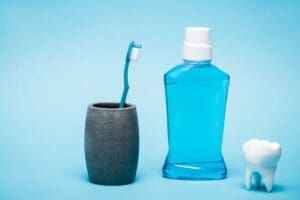What Happens After Invisalign Treatment?
Posted on October 30, 2023

Invisalign has become a popular choice for individuals looking to straighten their teeth without the hassle of traditional braces.
The clear aligners are discreet, comfortable, and offer great results. However, many people are left wondering what happens once they finish their treatment and remove their last set of aligners.
After completing Invisalign treatment, it is crucial to understand the importance of post-treatment care in order to maintain the results achieved. This includes wearing retainers, scheduling follow-up appointments with your orthodontist, and adopting good oral hygiene practices.
By taking these steps, you can ensure that your new smile lasts a lifetime. Now, let’s delve into the details of what you can expect after Invisalign treatment and how to keep your teeth in their newly aligned positions.
The Final Appointment
The last orthodontic appointment is a crucial step in completing the Invisalign treatment and achieving the desired outcome of straighter teeth.
During the last orthodontic appointment for Invisalign treatment, the orthodontist will evaluate the progress and make any necessary adjustments to ensure that the teeth are properly aligned. This appointment typically involves removing the final set of aligners and examining the teeth to ensure that they have shifted into their desired positions.
The orthodontist may also take impressions or scans of the teeth to create retainers or other post-treatment appliances. They will provide instructions on how to properly care for the teeth and retain the results achieved through the Invisalign treatment.
Retainers: Your Post-Invisalign Companions
After completing Invisalign treatment, your teeth may still have a tendency to shift back to their original positions. This is because it takes time for the bones and tissues surrounding the teeth to stabilize in their new positions.
Retainers are designed to hold your teeth in place, preventing any unwanted movement. By wearing retainers as directed by your orthodontist, you can maintain the results achieved through Invisalign and enjoy a long-lasting, beautiful smile.
Types of Retainers
Retainers are vital orthodontic devices, custom-made to hold teeth in place after braces and prevent them from shifting back to their original positions. This section will explore the various types, each with unique attributes, to help you identify the right match for sustaining your perfect smile.
-
Removable Retainers
These retainers are similar in appearance to Invisalign aligners. They are custom-made to fit your mouth and are typically worn full-time for the first few months after treatment.
Over time, the wearing schedule may be reduced to wearing them only at night. Removable retainers are easy to clean and can be taken out for eating, brushing, and flossing.
-
Fixed Retainers
Unlike removable retainers, fixed retainers are bonded to the back of your teeth using dental adhesive. This type of retainer is a thin wire that is not visible when you smile.
Fixed retainers are a great option for those who may forget to wear or misplace their removable retainers. However, they require extra attention during oral hygiene routines to ensure proper cleaning.
Retainers are essential companions after completing Invisalign treatment. They help maintain the results achieved and prevent any unwanted tooth movement.
Post-Treatment Oral Hygiene
Once an Invisalign treatment is completed, it’s important to maintain good oral hygiene post-treatment to keep your teeth healthy and ensure the longevity of your results.
Here are some tips for post-treatment oral hygiene after an Invisalign treatment:
-
Wear Your Retainer as Prescribed
After completing your Invisalign treatment, your orthodontist will provide you with a retainer. It’s essential to wear your retainer as prescribed, whether it’s full-time or just at night. This will help maintain the position of your teeth and prevent them from shifting back to their original positions.
-
Brush and Floss Regularly
 Maintaining good oral hygiene is crucial for the overall health of your mouth. Continue to brush your teeth at least twice a day using a soft-bristle toothbrush and fluoride toothpaste.
Maintaining good oral hygiene is crucial for the overall health of your mouth. Continue to brush your teeth at least twice a day using a soft-bristle toothbrush and fluoride toothpaste.Be sure to brush all surfaces of your teeth, including the front, back, and chewing surfaces. Don’t forget to brush your tongue as well to remove any bacteria or food particles.
Flossing is equally important, as it helps remove plaque and food debris from between your teeth and along the gumline. Use a gentle back-and-forth motion to clean between each tooth, and be thorough but gentle to avoid causing any damage to your gums.
-
Clean Your Retainer Properly
Your retainer needs to be kept clean to prevent the buildup of bacteria. Remove your retainer before brushing your teeth, and use a soft toothbrush and mild soap to gently clean it. Rinse it thoroughly with lukewarm water before placing it back in your mouth. Avoid using hot water, as it can distort the shape of your retainer.
-
Avoid Foods and Drinks That Stain
Certain foods and drinks can stain your teeth, undoing the effects of your Invisalign treatment. Limit your consumption of coffee, tea, red wine, and highly pigmented foods like berries or tomato sauce. If you do consume these items, make sure to brush your teeth or rinse your mouth with water afterward to minimize staining.
-
Visit Your Dentist Regularly.
Even though your Invisalign treatment is complete, it’s still important to visit your dentist regularly for check-ups and cleanings. These visits allow your dentist to monitor the health of your teeth and ensure that your retainer is fitting properly. Your dentist can also provide professional cleanings to remove any stubborn plaque or tartar that may have accumulated
-
Dietary Adjustments Post-Invisalign
If you have recently completed your Invisalign treatment, it’s important to make some dietary adjustments to ensure the long-term success of your treatment.
Here are some tips for making the right dietary choices after Invisalign:
-
Take It Slow
Your teeth and gums may be sensitive after Invisalign treatment, so it’s important to start with soft foods and gradually reintroduce harder foods as your mouth adjusts. Stick to softer foods like yogurt, mashed potatoes, and soup in the first few days to give your mouth time to heal.
-
Avoid Sticky and Chewy Foods
During Invisalign treatment, it’s best to stay away from sticky and chewy foods that can damage your aligners or get stuck in between your teeth. This includes foods like gum, caramel, and taffy. These foods can also cause your aligners to become dislodged or not fit properly, which can affect your treatment progress.
-
Cut Down on Sugary Foods and Drinks
Sugary foods and drinks can lead to tooth decay and cavities, which can be particularly problematic during Invisalign treatment. The aligners can trap sugar against your teeth, increasing the risk of dental issues. Opt for healthier alternatives like fruits and vegetables, and drink water instead of sugary beverages.
-
Be Mindful of Staining Foods and Drinks
Just like with traditional braces, certain foods and drinks can stain your aligners and teeth. Dark-colored beverages like coffee, tea, and red wine, as well as foods like berries and tomato sauce, can leave stains on your aligners and teeth.
It’s best to minimize consumption of these items or brush your teeth and rinse your aligners immediately after consuming them.
The Lifelong Benefits of Invisalign Treatment
Invisalign treatment offers a multitude of lifelong benefits, which include:
 Improved oral health and hygiene due to easier cleaning of straightened teeth.
Improved oral health and hygiene due to easier cleaning of straightened teeth.- Enhanced self-confidence and improved self-esteem from having a straight and beautiful smile.
- Reduced risk of dental problems such as tooth decay, gum disease, and tooth loss.
- Improved bite and alignment can prevent jaw pain and headaches in the long run.
Embracing Your Smile’s Evolution: Expert Post-Treatment Care Insights from Parker Orthodontics
The journey to a perfect smile extends beyond the last day of your Invisalign treatment, ushering in a vital maintenance phase to preserve your teeth’s new alignment. Parker Orthodontics emphasizes the necessity of a tailored post-treatment regimen, particularly advocating for the consistent use of retainers to keep teeth precisely in place.
Our orthodontic connoisseurs offer insight into maintaining retainer hygiene, making informed dietary decisions, and the importance of regular orthodontic consultations. With a commitment to these practices, you can ensure the durability of your orthodontic investment and continue to showcase your smile with confidence and pride.

